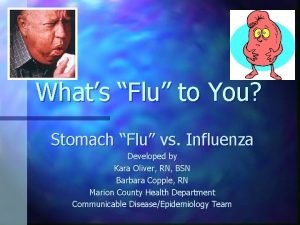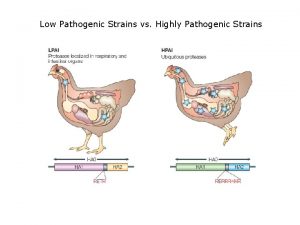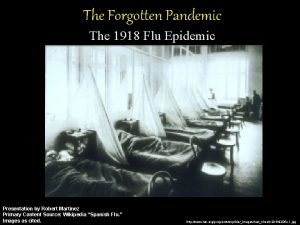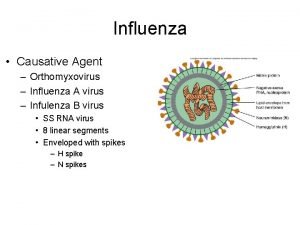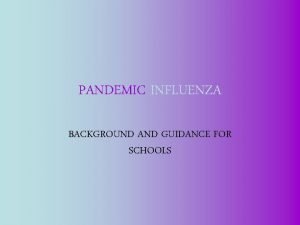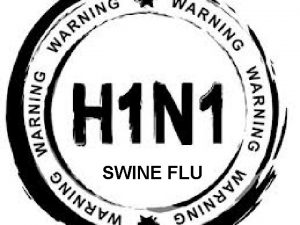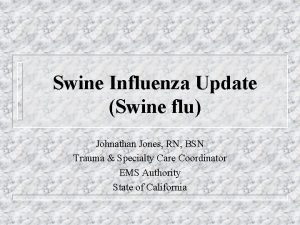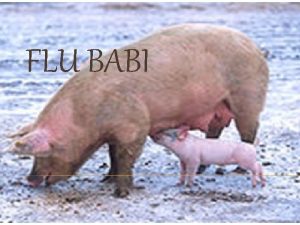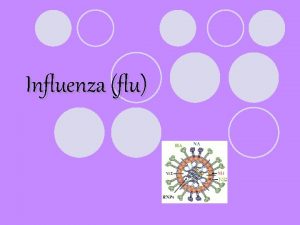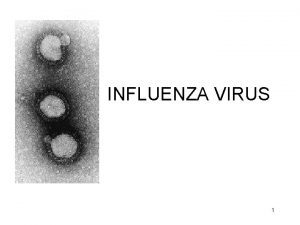Swine Flu Guidelines Recommendations for Preventing Influenza Spread












- Slides: 12


Swine Flu Guidelines & Recommendations for Preventing Influenza Spread in Children By Gehan A Alsawah, MD Lecturer of Pediatrics, Pediatric Cardiology Unit

Swine Flu • New viruses emerge due to mix of Swine, Human and/or Avian Influenza. • Now, there are four main subtypes isolated in pigs: H 1 N 1 H 1 N 2 H 3 N 1 • H 1 N 1 spread quickly from person-to-person.

Swine Flu How does this new H 1 N 1 virus spread? • As seasonal influenza; coughing, sneezing, by people with influenza. Sometimes by touching something with flu viruses on it and then touching their mouth or nose. • No risk from drinking water. How long can influenza viruses remain viable on objects? • Up to 2 -8 hours after being deposited on the surface.

Swine Flu Planes for operation in Pandemics. • Emergency warning signs in children that need urgent medical attention: • Fast breathing or difficult breathing. • Bluish or grey skin discoloration. • Not drinking enough fluids. • Not fully conscious. • Flu like symptoms (Fever, cough, Sore throat, Body aches, Diarrhea in some cases) improve but return with fever and severe cough.

Swine Flu Centers for Disease Control and Prevention (CDC) Guidelines to Prevent Spread of Influenza in Children: • Influenza vaccine to all children from 6 m to 19 y. • Vaccine to care providers to children. • Children and care providers oriented to hand washing or use alcohol based hand cleaners (wash hands for 15 -20 sec). • Keep the child care environment clean and make sure that supplies are available. • Cover nose and mouth during sneezing or coughing.

Swine Flu Centers for Disease Control and Prevention (CDC) Guidelines to Prevent Spread of Influenza in Children. • Observe all children for symptoms of respiratory illness; infants and young children can become quite ill with influenza very quickly and might require urgent medical attention and hospitalization. • Encourage parents of sick children to keep their children home. • Encourage sick care providers to stay home. • Consult your local health department when increases in respiratory illnesses occur in the child care sitting.

Swine Flu Centers for Disease Control and Prevention (CDC) Guidelines to Prevent Spread of Influenza in Children. • Health care providers should stay informed on what is happening in their communities. • Sick children may infect others up to 10 days after the symptoms start, adults may infect others while sick for 5 -7 days. • Keep a record for persons with various illnesses (e. g. respiratory, diarrhea, rash) by day or at least by week.

Swine Flu Centers for Disease Control and Prevention (CDC) Guidelines to Prevent Spread of Influenza in Children. • Follow public health advice regarding school closures, avoiding crowds. • Supply of over-the-counter medicines, alcohol based cleaners.

Swine Flu Epidemiological activities must take place: • Active surveillance in the countries where infection in humans have been identified. • Studies of health care workers who were exposed to patients infected with the virus to see if became infected. • Studies of households and other contacts of people who were confirmed to have been infected to see if they become infected. • Study of a public schools.

Swine Flu Preventing the Flu: Good Health Habits Can Help Stop Germs Fact Sheet 1 -Avoid close contact with people who are sick. When you are sick, keep your distance from others to protect them from getting sick too. 2 -Stay home when you are sick. Stay home from work, child care, school, and errands when you are sick, except to seek medical care. Keep sick children at home except to seek medical care. You will help prevent others from catching the illness. 3 -Cover your mouth and nose with a tissue when coughing or sneezing. Cover your nose and mouth with a tissue when you cough or sneeze. Throw the tissue in the trash after you use it. 4 -Wash your hands often. Washing your hands and the hands of your children often will help protect you from germs. 5 -Avoid touching your eyes, nose or mouth. Germs are often spread when a person touches something that is contaminated with germs and then touches his or her eyes, nose, or mouth. 6 - Practice other good health habits. Get plenty of sleep, be physically active, manage your stress, drink plenty of fluids, and eat nutritious food.

